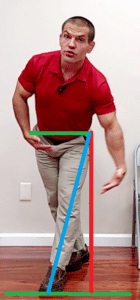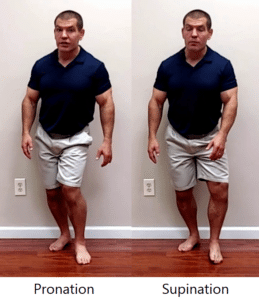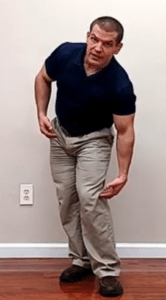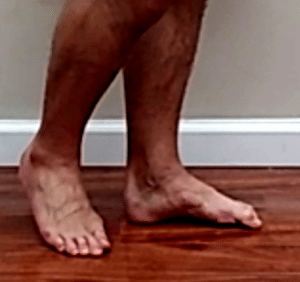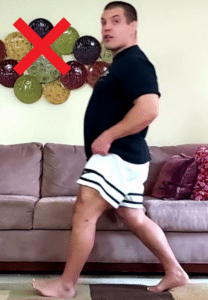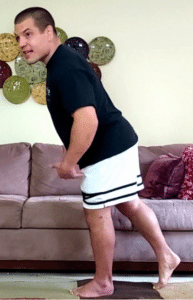Do You Get Pain When Walking?
In this video, you'll learn 3 common mistakes that may be causing your pain. Plus, learn tips to avoid them so you can have longer, pain-free walks.
3 Mistakes To Avoid To Walk Without Pain
When we move, we move in three primary planes:
- forward/backward (sagittal plane)
- side-to-side (frontal plane)
- rotational (transverse plane)
Each of the three mistakes I'll describe targets one of these three planes. And the first one targets the side-to-side plane.
Walking Mistake 1
I'm starting with this one because it's the mistake that's most likely to cause falls.
Sometimes, when people are walking, they'll cross their leg too far across midline.
What that does is make you more likely to get your feet tangled up. This in turn can lead to to tripping and falling over your own feet.
This may happen due to weakness in the hip muscles of your stance leg or stiffness in the inner thigh muscles on your swing leg.
Either way, crossing your feet across midline increases the risk of falls.
It can also lead to outer hip pain when walking.
When your leg goes too far inward, the muscles and tendons get stretched over the outside of your hip, becoming painful.
How To Walk Without Outer Hip Pain
On tip to walk without hip pain is to focus on keeping your feet hip-width apart when walking.
You may even want to think about pressing outward slightly, like an ice skater or a cross-country skier.
This activates your glute muscles, making you less likely to drop your hip out to the side and cross your leg across midline.
Walking Mistake 2
The second mistake is in the rotational or twisting plane, involving excessive internal rotation of your hip or pronation of your foot.
This problem affects all the joints in your leg, causing stress on the ligaments inside the knee.
Overpronation can also cause a twisting force at the knee.
Additionally, overpronation can lead to ankle and foot conditions such as tarsal tunnel syndrome and plantar fasciitis.
How To Walk Without Pain From Overpronation
To avoid this, think about hitting more on the outer side of your foot as it contacts the ground.
Grip the ground with your toes, scrunching your foot and doming your arch for a stable base to prevent foot flattening.
Engage your glute muscles simultaneously to prevent inward twisting of the knee as well.
Walking Mistake 3
The third mistake is in the front-to-back (sagittal) plane.
This one is probably the most controversial: heel striking.
Some people have been told to walk heel-to-toe by doctors or physical therapists.
However, this puts excessive impact on the heel, potentially causing problems like plantar fasciitis or heel spurs.
Heel striking transmits more force up your chain, potentially causing pain in the knee, hip, or lower back.
How To Walk Without Pain From Heel Striking
Instead, aim to hit with your whole foot at the same time, allowing the arch to absorb shock naturally.
These three tips may seem overwhelming, but they complement each other.
Exercises To Walk Without Pain?
There are exercises that can help you walk without pain as well.
However, exercises alone won't suffice as walking is a complex task requiring proper muscle coordination.
Your walking pattern is a habit, and just stretching and strengthening muscles won't change the habit or "re-code" your walking program.
In order to walk without pain, you may have go conscientiously change the way you walk for awhile.
Forming a new habit takes an average of 66 days, so be patient.
The best exercise for walking improvement is intentional walking.
Focus on these things when walking:
- Keeping feet approximately hip width apart
- Hitting on the outside of your foot with your arch domed
- Engaging your glute muscles
- Contacting the ground with your whole foot rather than just your heel
- Pushing off from your back foot rather than pulling forwards with your front leg
Sound overwhelming?
It is.
You can't possibly think about every aspect of your walking all at once.
So just pick the biggest problem, and focus on fixing that.
Then once that becomes part of your habitual walking pattern, then move on to the next problem.
Don't get frustrated.
It will take time, but the payoff of walking without pain and having better stability on your feet is worth it.
Need More Help To Walk Without Pain?
If you're in the St. Louis area and need help to walk without pain, we'd be happy to help you here at More 4 Life.
Just tap the button below to request an appointment with one of our specialist physical therapists.
Like this post? Here are some other posts about how to walk without pain:
5 Simple Tips To Fix Arch Pain Walking
How To Improve Walking Gait Instantly Without Exercises
How Much Walking Is Good For Arthritis? (Walk More With Less Pain)
Relieve Outer Hip Pain When Walking With ONE Exercise


